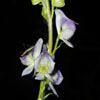|
HOME ABOUT LISA BERRY CONTACT INFO GIFT IDEAS LINKS REVIEWS REFERENCES Alpine Buttercup Alpine Gold Alpine Heather Alpine Lily Brown's or Wild Peony Camas Lily Corn Lily Crimson Columbine Elephant Heads Great Red Paintbrush Green Gentian Large-Leaf Lupine Little Elephant's Head Mariposa Lily Monkshood Mountain Bluebells Mountain Jewelflower Prairie Smoke Ranger Buttons Red Mountain Heather Rock Fringe Rosy Sedum Showy Penstemon Sierra Gooseberry Sierra Primrose Sierra Shooting Star Sierra Wallflower Snowplant Steer's Head Swamp Onion Towering Larkspur |
 Scientific Name: Aconitum Columbianum
Scientific Name: Aconitum ColumbianumCommon Name: Monkshood, Wolfsbane Family: Buttercup Color: Usually a deep blue or purple, but ranges from the occasional white or pale pink, to light blue or purple also. Description: This peculiar, hood-shaped flower consists of five petal-like sepals. The uppermost sepal curves upward and forward, forming the top of a hood. The bottom two sepals form the collar of the hood. Inside the flower is a cluster of reproductive parts and two hiding whitish petals. The flowers alternate at the top of a firm stem up to 6 feet high. The leaves are large and maple-like. Habitat: Moist semi-shaded creek beds and banks. Toxicity: Monkshood is extremely poisonous to livestock and humans. The name "Wolfsbane" comes from the medieval practice of poisoning darts to kill wolves. Comments: Because the flower opening of monkshood evolved into the size of a bumblebee, the flower"s natural pollinator, monkshood will not thrive in areas without bumblebee populations.    |
